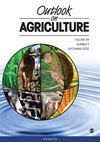Is it possible to attain the same soil organic matter content in arable agricultural soils as under natural vegetation?
IF 2.6
3区 经济学
Q1 AGRICULTURE, MULTIDISCIPLINARY
引用次数: 15
Abstract
Clearing natural vegetation to establish arable agriculture (cropland) almost invariably causes a loss of soil organic carbon (SOC). Is it possible to restore soil that continues in arable agriculture to the pre-clearance SOC level through modified management practices? To address this question we reviewed evidence from long-term experiments at Rothamsted Research, UK, Bad Lauchstädt, Germany, Sanborn Field, USA and Brazil and both experiments and surveys of farmers’ fields in Ethiopia, Australia, Zimbabwe, UK and Chile. In most cases SOC content in soil under arable cropping was in the range 38–67% of pre-clearance values. Returning crop residues, adding manures or including periods of pasture within arable rotations increased this, often to 60–70% of initial values. Under tropical climatic conditions SOC loss after clearance was particularly rapid, e.g. a loss of >50% in less than 10 years in smallholder farmers’ fields in Zimbabwe. If larger yielding crops were grown, using fertilizers, and maize stover returned instead of being grazed by cattle, the loss was reduced. An important exception to the general trend of SOC loss after clearance was clearing Cerrado vegetation on highly weathered acidic soils in Brazil and conversion to cropping with maize and soybean. Other exceptions were unrealistically large annual applications of manure and including long periods of pasture in a highly SOC-retentive volcanic soil. Also, introducing irrigated agriculture in a low rainfall region can increase SOC beyond the natural value due to increased plant biomass production. For reasons of sustainability and soil health it is important to maintain SOC as high as practically possible in arable soils, but we conclude that in the vast majority of situations it is unrealistic to expect to maintain pre-clearance values. To maintain global SOC stocks at we consider it is more important to reduce current rates of land clearance and sustainably produce necessary food on existing agricultural land.可耕地农业土壤中的土壤有机质含量是否可能与天然植被下的土壤有机物含量相同?
清除自然植被以建立耕地几乎总是导致土壤有机碳(SOC)的损失。是否有可能通过改良的管理实践将耕地土壤恢复到清除前的有机碳水平?为了解决这个问题,我们回顾了来自英国洛桑研究所(Rothamsted Research)、德国巴德Lauchstädt、美国桑伯恩农场(Sanborn Field)和巴西的长期实验的证据,以及埃塞俄比亚、澳大利亚、津巴布韦、英国和智利农民田地的实验和调查。在大多数情况下,耕地土壤有机碳含量在毁林前的38-67%之间。归还作物残余物,添加肥料或在耕地轮作中包括放牧期增加了这一点,通常达到初始值的60-70%。在热带气候条件下,砍伐后的有机碳损失尤为迅速,例如,津巴布韦小农的农田在不到10年的时间里损失了50%。如果种植产量更高的作物,使用化肥,玉米秸秆被归还,而不是被牛吃掉,损失就会减少。森林砍伐后有机碳损失总体趋势的一个重要例外是,在巴西高度风化的酸性土壤上清除塞拉多植被,转而种植玉米和大豆。其他例外情况是每年不现实地大量施用肥料,以及在高度保持soc的火山土壤中长时间放牧。此外,在低降雨地区引入灌溉农业,由于增加了植物生物量产量,可以使有机碳增加到超过自然值的水平。由于可持续性和土壤健康的原因,在耕地土壤中保持尽可能高的有机碳是很重要的,但我们得出结论,在绝大多数情况下,期望保持砍伐前的值是不现实的。为了维持全球有机碳储量,我们认为更重要的是降低目前的土地清理速度,并在现有的农业用地上可持续地生产必要的粮食。
本文章由计算机程序翻译,如有差异,请以英文原文为准。
求助全文
约1分钟内获得全文
求助全文
来源期刊

Outlook on Agriculture
农林科学-农业综合
CiteScore
5.60
自引率
13.30%
发文量
38
审稿时长
>36 weeks
期刊介绍:
Outlook on Agriculture is a peer reviewed journal, published quarterly, which welcomes original research papers, research notes, invited reviews and commentary for an international and interdisciplinary readership. Special attention is paid to agricultural policy, international trade in the agricultural sector, strategic developments in food production, the links between agricultural systems and food security, the role of agriculture in social and economic development, agriculture in developing countries and environmental issues, including natural resources for agriculture and climate impacts.
 求助内容:
求助内容: 应助结果提醒方式:
应助结果提醒方式:


